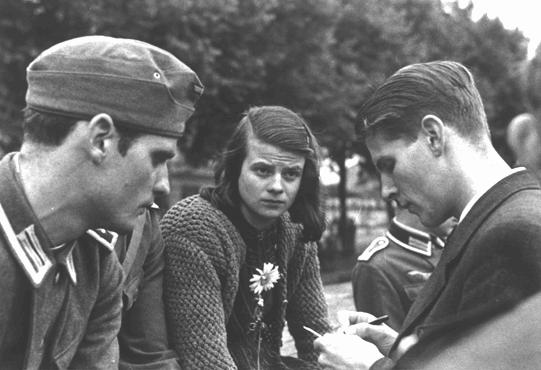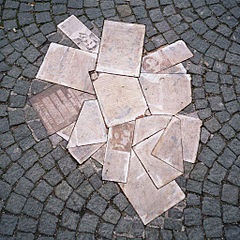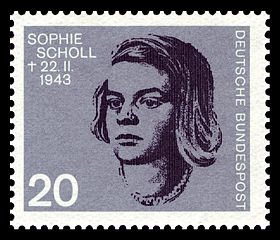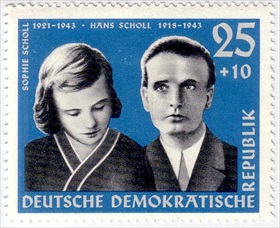WHITE ROSE SIBLINGS PUT TO DEATH
Munich, Germany · February 22, 1943
On this date in 1943 siblings Sophie (age 21) and Hans Scholl (24) and their friend Christoph Probst (24), members of the underground White Rose (Weiße Rose) resistance circle, were charged with sedition for writing, printing, and distributing anti-Nazi leaflets and “tried” by “Hitler’s Hanging Judge,” the notorious Nazi jurist Roland Freisler. (A year earlier Freisler, along with the malevolent likes of Reinhard Heydrich and Adolf Eichmann, had attended the Wannsee Conference on scoping and implementing the “final solution” to the Jewish problem.) The White Rose was a nonviolent/intellectual resistance group of university students and professors engaged in an anonymous leaflet campaign, lasting from mid-1942 until February 1943, that called for active opposition to Hitler’s totalitarian regime. The Scholls had originally been enthusiastic supporters of the German renewal promised by National Socialism, and they enrolled in the Hitler Youth organization. But as their realization of Nazi atrocities directed against Jews on the Eastern Front grew, so did their moral outrage. Betrayed by a custodian in the act of distributing their flyers, the Scholls were found guilty in Freisler’s court and beheaded on the same day at Munich’s Stadelheim Prison. After their deaths, their sixth and last leaflet was smuggled to the Allies, who retitled it “The Manifesto of the Students of Munich” and air-dropped millions of copies over Germany. Members of the White Rose, especially the Scholls, became heroes in postwar Germany. One of Germany’s leading literary prizes is called the Geschwister Scholl prize (the “Scholl Siblings” prize). Many local streets and squares in Germany have been named after the brother and sister. Geschwister-Scholl-Schule is the most common school name in Germany. In 2003 Germans were invited by a television broadcaster to choose the top ten most important Germans of all time. Voters under the age of 40 helped Hans and Sophie Scholl finish in fourth place, above Bach, Goethe, Gutenberg, Bismarck, and Einstein. If the votes of young viewers alone had been counted, the Scholls would have ranked first. Several years earlier, readers of a German women’s magazine voted Sophie Scholl “the greatest woman of the twentieth century.”
[amazon_carousel widget_type=”ASINList” width=”600″ height=”200″ title=”Recommended Reading” market_place=”US” shuffle_products=”False” show_border=”False” asin=”1851685367,0415121345,0300044801,1400060001,052100358X,0752455117,0822213524,0819560863,1562544519,1586175572″ /]
German White Rose Resistance Movement, 1942–1943
 |  |
Left: From left, Hans Scholl (1918–1943), Sophie Scholl (1921–1943), and Christoph Probst (1918–1943), Munich, 1942.
![]()
Right: The area in front of the main building of Ludwig Maximilian University of Munich is named “Geschwister-Scholl-Platz.” Facsimiles of the last White Rose flyer are set in the ground.
 |  |
Left: Sophie Scholl on a 1964 West German postage stamp.
![]()
Right: Hans and Sophie Scholl on a 1961 East German postage stamp. Reputedly, the last words of Hans Scholl were “Long live freedom!” (“Es lebe die Freiheit”). Several versions of Sophie Scholl’s last words include “. . . your heads will fall as well” and “God, you are my refuge into eternity.”
Scenes from 2005 German Film Sophie Scholl–Die letzten Tage (Sophie Scholl: The Final Days) and 2005 Academy Award Nominee for Best Foreign Film
![]()

 History buffs, there is good news! The Daily Chronicles of World War II is now available as an ebook for $4.99 on Amazon.com. Containing a year’s worth of dated entries from this website, the ebook brings the story of this tumultuous era to life in a compelling, authoritative, and succinct manner. Featuring inventive navigation aids, the ebook enables readers to instantly move forward or backward by month and date to different dated entries. Simple and elegant! Click
History buffs, there is good news! The Daily Chronicles of World War II is now available as an ebook for $4.99 on Amazon.com. Containing a year’s worth of dated entries from this website, the ebook brings the story of this tumultuous era to life in a compelling, authoritative, and succinct manner. Featuring inventive navigation aids, the ebook enables readers to instantly move forward or backward by month and date to different dated entries. Simple and elegant! Click 











